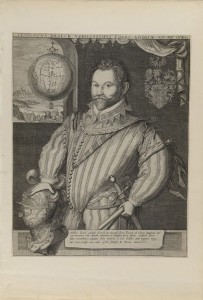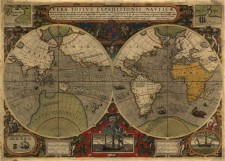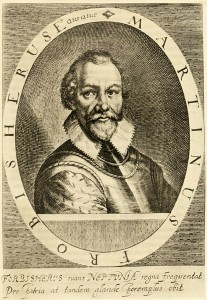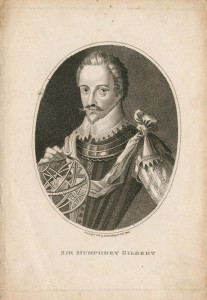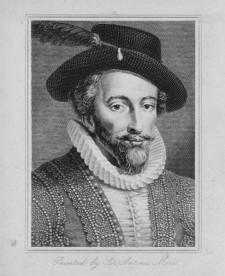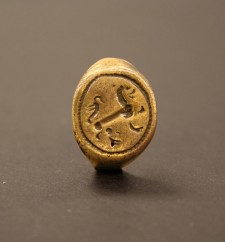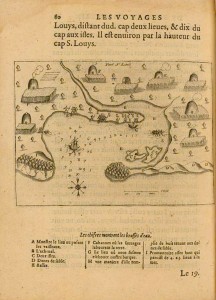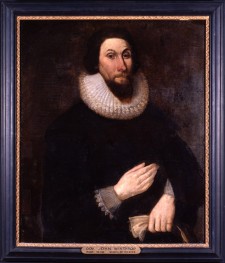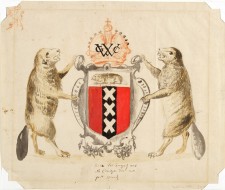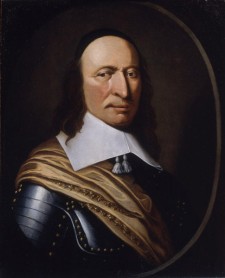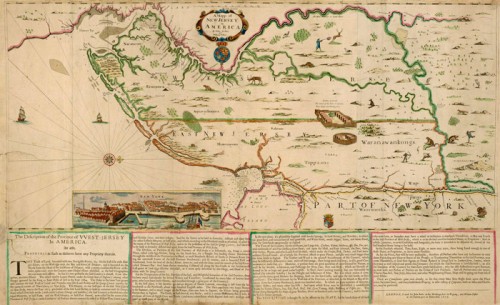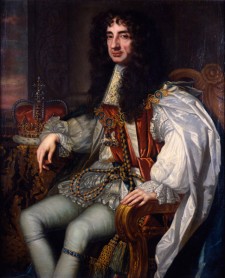-
- Introduction
- Colonies and Empires
- The Explorers
- Jacques Cartier 1534-1542
- Samuel de Champlain 1604-1616
- Étienne Brûlé 1615-1621
- Jean Nicollet 1634
- Jean de Quen 1647
- Médard Chouart Des Groseilliers 1654-1660
- Pierre-Esprit Radisson 1659-1660
- Nicolas Perrot 1665-1689
- René-Robert Cavelier de La Salle 1670-1687
- Charles Albanel 1672
- Jacques Marquette 1673
- Louis Jolliet 1673-1694
- Louis Hennepin 1678-1680
- Daniel Greysolon Dulhut 1678-1679
- Louis-Armand de Lom d’Arce, baron Lahontan 1684-1689
- Pierre de Troyes 1686
- Pierre Le Moyne d’Iberville 1686-1702
- Antoine Laumet dit de Lamothe Cadillac 1694-1701
- Pierre Gaultier de Varennes et de La Vérendrye 1732-1739
- Economic Activities
- Population
- Daily Life
- Heritage
- Useful links
- Credits
Colonies and Empires
Other Colonial Powers
From the discovery of America by Christopher Columbus, in 1492, many European powers sought to take possession of the continent’s land and its riches. While the Spanish and the Portuguese quickly succeeded in taking exclusive ownership of the territories of South America, the French, the English, the Dutch and the Swedes were forced to divide up the northern part of the continent.
This article proposes a panorama of the European colonies established in North America that the French had to deal with and indeed, compete with. It takes us from the shores of Florida, where the Spanish attempted to settle from the early 16th century, to Carolina and Georgia, two colonies founded by the British 200 years later. It brings us to the colony of New Amsterdam (today New York), founded by the Dutch in 1614; Plymouth, where the Mayflower pilgrims landed six years later, and then New Sweden, established in 1638.
The author sketches a portrait of communities that were established with sometimes identical, yet often different objectives and means. This study thus allows readers to discover a multitude of human adventures, both individual and collective, that encountered success, but also failure. It highlights as well the specific characteristics of each of these settlements that in many respects contrast with those of New France.
The Other European Settlements in North America (show)
From the first quarter of the sixteenth century to the time the United States gained its independence, there were many Spanish, French, English, Dutch, German, and even Finnish-Swedish, settlements on the coast of North America, bordered on the north by Acadia and Maine, and on the south by Florida. Not all of them thrived; indeed, some were quite ephemeral due to a combination of epidemics, Native American hostility and, very often, the fact that settlers were insufficiently prepared for life on the continent. That is, when the colonies did not exist on paper only. For a long time, geostrategic considerations related to privateering were the primary concern on the coasts of North America; natural resources were secondary. The objective was to either establish corsair bases to strike Spanish ships or ports, or to occupy land to prevent the establishment of such bases. North America was also an obstacle to be bypassed on the route to East India and its immense wealth. Exploiting the land’s resources (tobacco, rice, lumber) came second, and Europeans did so alone or with African slaves (who helped quite involuntarily), but they never lost sight of their initial objectives. North America could promise religious freedom, with its share of exceptions, and prosperity or, to a lesser extent, economic independence for the middle classes. However, besides the numerous commercial failures and innumerable lives sacrificed, North America was also synonymous with captivity for some and the irreparable loss of ancestral lands for others, as the European colonies expanded.
The Sixteenth Century: “Vain” European Attempts (show)
Settlement Attempts by the Spanish, from Florida to the Chesapeake BayOn the whole, the Spanish were only very marginally interested in North America. They focused their attention on the Caribbean, then on Mexico and, finally, on Peru, whose mineral wealth they exploited. North America appeared to pale in comparison; the north had a harsh climate and seemingly poor soil, and further south, the Terra Florida was of interest mainly because of its strategic location for protecting the Bahamas Strait, through which the strong currents forced ships to pass on the return trip to Europe. One, and sometimes the only, objective of all the French and English settlements in Florida and Virginia was to possess a corsair base to attack Spanish ships loaded with the riches of the Americas that made Spain the only super power in its “golden century”. It was therefore vital for the Spanish to prevent their European rivals from settling in the region. They would occupy the territory if necessary to keep potential intruders at a distance.
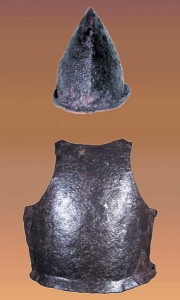 http://preservationvirginia.org, http://historicjamestowne.org” width=”180″ height=”300″ class=”size-medium wp-image-3096″ />
http://preservationvirginia.org, http://historicjamestowne.org” width=”180″ height=”300″ class=”size-medium wp-image-3096″ />Cabasset and Breastplate
The Spanish made one of the first attempts at settlement, long before the French and the English. It was led by Lucas Vázquez de Ayllón, a wealthy entrepreneur from Hispaniola, who transported several hundred settlers and slaves, as well as a few missionaries, to a site near the mouth of the Savannah River in July 1526 then founded San Miguel de Gualdape in October of the same year, probably near Sapelo Island (Georgia). Vázquez de Ayllón died shortly thereafter, and dissension, coupled with pressure from Native peoples, spelled the end of the small colony.
In 1559, Tristán de Luna y Arellano found himself at the head of a strategic program aimed at linking Pensacola and Santa Elena (present-day Parris Island) — and, thus, the two coasts of the Florida peninsula — but that program met with failure. It was followed by two attempts at settlement by the French, one at Charlesfort (Parris Island, South Carolina) in 1562, under the direction of Jean Ribault, a Huguenot from Dieppe, and another further south, at Fort Caroline (Jacksonville, Florida) in 1564–1565, overseen by René Goulaine de Laudonnière, also a Huguenot.
When Pedro Menéndez de Avilés, adelantado (governor) of Florida under Philip II, seized Fort Caroline in August 1565, he built two small forts on the sites occupied by the French and founded San Agustín (Saint Augustine, Florida, the oldest city founded by the Spanish in what is now the United States), then Santa Elena. These two bases were meant to prevent Spain’s enemies — Huguenot corsairs in particular — from settling in Florida.
In 1570, the Jesuits, seeing that the evangelization of Native peoples in Florida was producing little result, sought to establish a mission further north, on the river that would later bear the name James. This undertaking was led by Menéndez and Paquiquineo, a Native American from the Chesapeake Bay area who had been Hispanicized in the 1560s and adopted the name Don Luis de Velasco. Passage to “Tartary” was among the promises made by Don Luis, who sung the praises of his native region. Accompanied by eight Jesuits and a young boy, he settled on the banks of the Pamunkey River, but the Spaniards soon grew disillusioned because the region was plagued by famine. Relations with the Native peoples became tense as well, and Don Luis ended up joining his people. He returned only to massacre the Jesuits, sparing just the boy, Alonso, who relayed the events. Without news of the expedition, Menéndez set off for the region in 1572 and found only Alonso. Upon learning that the Jesuits had been massacred, he resolved to get revenge with the same vigour he had displayed against the French a few years earlier. At that point, the colonization of Florida was an unending series of failures, massacres and acts of vengeance.
John Hawkins and the African Slave Trade
John Hawkins was the son of one of the pioneers of trade with Africa and Brazil under Henry VIII. The black slave trade had been established long before, but the rapid growth of sugar plantations stimulated the demand for slaves, especially in Santo Domingo, but also in Cuba, Jamaica and Puerto Rico. Hawkins decided to engage in what could be a very lucrative trade, and in 1562 he led the first of his three expeditions, in violation of the Iberian monopoly.
He captured 300 slaves in Sierra Leone and managed to sell them for furs, sugar, ginger and pearls. At the same time, Jean Ribault, who had left Florida and returned to Dieppe, sought refuge in England because of the first War of Religion. He brought Florida’s strategic location — close to the route of the return fleet and Spanish fortresses such as Cuba — to the attention of the English, particularly in maritime circles.
When Hawkins undertook his second voyage, in October 1564, the diplomatic climate had deteriorated. He captured slaves on the coasts of Africa, sold them for a profit in the Caribbean, then travelled up the coast of Florida as far as the French settlement of Fort Caroline, which was under Laudonnière’s command. The settlement was on its last legs, and Hawkins offered supplies, but his mission also had a strategic purpose; he was there as an observer. Fort Caroline was spared from famine, and Ribault arrived to offer support. In vain. Pedro Menéndez de Avilés attacked the fort and massacred almost all the French (Protestants) he found there, including Ribault.
Hawkins’ third expedition went smoothly until one of the ships was damaged in a storm. Needing to make repairs, they had no choice but to stop at San Juan de Ulúa, next to Vera Cruz, on the coast of Mexico. Attacked by the Spanish, they were forced to flee. Sir Francis Drake, Hawkins’ cousin, was a member of the crew, and the experience fuelled his hate of the Spanish. After his round-the-world expedition (1577–1580), devoted largely to the plundering of Spanish possessions and ships, Drake led numerous excursions against Spanish settlements in North America, including Saint Augustine, which he ravaged in 1586.
Despite these few attempts, interest remained focused on the Caribbean and Spain’s wealth. Of particular importance was the capture of Panama, the “key” to Peru’s resources, especially the silver from Potosí’s mines, which passed through the region. The northern part of the Americas — “Florida”, in the broad sense of the word — remained marginal.
The Route to China: The Northwest Passage
Something else drew England’s attention to North America, aside from Florida’s strategic location: the possibility of finding the mythical Northwest Passage to the Orient — Cathay (China), Cipangu (Japan) and India — and its immeasurable wealth.
The first route tried was along the northeast, around the North Cape. English travellers had reached the Persian Gulf through the White Sea and the Volga, but no one had managed to go around the north of Russia. In a text written in 1566 but published only in 1576, Sir Humphrey Gilbert claimed that it would be much easier to pass through the northwest. He based this claim as much on the writings of classical authors (Plato, Aristotle, Strabo …) as on the Bible (Esther) and the work of the most contemporary cartographers (Ortelius, Mercator).
The voyage itself would be undertaken by Martin Frobisher (1576, 1577, 1578) and John Davis (1585, 1586, 1587). An experienced sailor, Frobisher had participated in expeditions to Africa and elsewhere. He was at the service of an association of London merchants, the Moscovia Company, and influential members of Elizabeth I’s court. The three expeditions, which got only as far as the bay named after Frobisher (where Iqaluit is located), in Baffin’s Land, did not produce conclusive results; the minerals retrieved had no more value than Jacques Cartier’s “diamonds”, and the goal remained out of sight, due in part to the inclement climate and the rather imprecise geography of the time. An Inuit man was taken back to England, and his features recalled those of the “Tartars”, raising hopes that the Orient might not be far off. John Davis, a friend of the Gilbert family, made a more methodical voyage along the coast of Greenland, reaching a latitude of 72° N and Baffin Bay. That voyage came to an end when England faced the threat of invasion by the Spanish Armada sent by Philip II, which was still considered invincible.
A Catholic Refuge?
For a long time, therefore, the English viewed North America as nothing more than a stop on the route to East India, an obstacle to be bypassed through the northwest or, at best, a corsair base from which to strike Spain. Long-term settlement was never envisaged.
In 1578, however, Sir Humphrey Gilbert received letters patent authorizing him to explore the region north of Spanish Florida and establish permanent settlements there. The first expedition did not make it past the coast of Ireland.
Starting in 1570, England toughened its legislation against Catholics, particularly Jesuits. The new measures were based on the principle that one could not serve two masters and that Catholics, released from allegiance to Elizabeth when she was excommunicated (in 1570), could not be loyal subjects. Catholicism was therefore synonymous with high treason. Notwithstanding that, some Catholic gentlemen remained loyal to Her Majesty. Sir Thomas Gerrard, who had considered creating a refuge for Lancashire Catholics in Ireland as early as 1569, and Sir George Peckham approached Gilbert and proposed the establishment of a community on the other side of the Atlantic where Catholics could live their faith in peace. The first English colony founded in North America for reasons that were not essentially economic and geostrategic would have been a Catholic refuge, which is ironic in view of what would follow in the history of the United States, long marked by hostility to Catholicism. Gilbert’s death in a shipwreck off the coast of Newfoundland in 1583 contributed to the project’s demise, as did pressure exerted by Spain, mainly through ambassador Bernardino de Mendoza. Diplomatic correspondence shows that Spain was particularly worried about England’s plans.
On what would be his last expedition, Gilbert officially took possession of Newfoundland in the name of Queen Elizabeth; his letters patent, valid six years, were thus well confirmed. When he died on the return trip, his rights were transferred to his half brother, Sir Walter Raleigh, a courtier who was increasingly esteemed by the sovereign.
Richard Hakluyt, Walter Raleigh and the “Lost Colony” of Roanoke
Walter Raleigh had his eye on the lands located between the thirty-fifth and fortieth parallels, latitudes similar to those of the Mediterranean regions. He hoped that Mediterranean crops could be grown there to make England economically independent as far as those products were concerned. That was a fallacious analogy, unbeknownst to all at the time. The region held another advantage; it was close to Spain’s possessions and the Bahamas Strait, but in a more northerly location and, hence, less exposed than the French settlements in Florida. The English seemed to have learned a lesson.
Guided by a Portuguese pilot who was fiercely hostile to Spain, Philip Amadas and Arthur Barlowe left on a reconnaissance voyage in the spring of 1584. In July, they arrived in the Outer Banks region (in present-day North Carolina), a narrow strip of land sheltering a few islands, including Roanoke, which appeared to afford protection against raids by the Spanish. The initial contact with the local Native American chief, Wingina, was peaceful and encouraging. Upon their return, Amadas and Barlowe embellished the second version of their report even further, praising the region even more. Virginia, named in honour of Elizabeth I, was described as a land of milk and honey inhabited by Native peoples who seemed quite well disposed towards the English, implying that colonization would be relatively easy. Amadas and Barlowe took two Native Americans back with them, Manteo and Wanchese, who learned English and became interpreters. In the meantime, the diplomatic climate had grown quite tense, particularly between England and Spain, whose ambassador had been deported in January 1584.
That same year, Richard Hakluyt wrote a confidential treatise for Elizabeth I that has become known as the Discourse on Western Planting. In it, he advocated a vigorous settlement policy in North America, citing evangelization, socio-economic reasons and geostrategic considerations, all for the purpose of countering Spain.
Hakluyt was by no means the first to advocate the evangelization of Native Americans. He explained that it would be necessary to “plant” one or two well-fortified settlements, then learn the language and customs of the Native peoples to win them over to the “nectar of the Gospel … slowly and with good judgement”, while avoiding a method that was too direct, which was, in his opinion, the reason Spanish missionaries had been massacred in Florida. Yet, he readily acknowledged that both Spanish and Portuguese missionaries had achieved some commendable results, though their religion was tinged with “superstition”. In comparison, Hakluyt asked quite rhetorically how many “infidels” the English had converted. The answer was obvious: none.
According to Hakluyt, there was another advantage to sending pastors to North America. Too many of them were idle, leading to increased contestation and dissension, an implicit reference to Puritanism and separatism. If pastors were sent to convert the Native Americans, they would be sufficiently occupied to settle for the Anglican version of Protestantism. Furthermore, they would help prevent mutinies and ensure a certain level of obedience among the colonists, giving the colony some basic stability, which would increase its chances of survival. North American settlement would also ease population pressures in the prisons and the country as a whole, provide work for the unemployed and revitalize the maritime sector and related activities, at least in the coastal regions.
Hakluyt made it a point of citing, among the geopolitical considerations, the French precedent in Florida, referring specifically to Jean Ribault. The failure of the French progressively emerged as the counter example par excellence, and the English settlement attempts that would follow (Roanoke and Jamestown) would take into account the proximity of the Spanish, which had proved fatal for the French. The Northwest Passage to China was not forgotten, nor the “donation” (the Inter coetera bull of 1493 that confirmed the Treaty of Tordesillas the following year) made by Pope Alexander VI, who, as “a native of Spain”, was deprived of all legitimacy. Hakluyt was not the first to contest the Iberian monopoly in the Americas, but he set his arguments at the heart of that contestation and its legal premise.
Finally, near the end of his text, Hakluyt presented the future English settlements on the other side of the Atlantic as refuges for Christians the world over who were forced into exile because of their religion. He must have been thinking of the Huguenots who sought refuge after the St. Bartholomew’s Day Massacre (1572). Unlike Gilbert, however, he opposed the settlement of “papists” in the English colonies, due to their natural tendency to support the king of Spain. Because Catholics were, by nature, disloyal subjects, they would, in his opinion, be the first to betray and compromise the colony’s existence. Therefore, only Protestants were to be sent.
Since the results of the reconnaissance undertaken by Amadas and Barlowe were sufficiently encouraging, a new expedition, led by Richard Grenville, set out in 1585. The English settled at Roanoke, but the site was not considered optimal; among other things, the shoals prevented the approach of ocean-going vessels. The colonists were left under the direction of Ralph Lane when Grenville returned to England. Lane explored the region and discovered the Chesapeake Bay, which seemed more appropriate because it was deeper.
The Spanish were aware of England’s plans, thanks to their effective network of spies, and in December 1585 they dispatched ships from the Caribbean to inflict on Roanoke the fate the French had suffered twenty years earlier. Unable to find the English settlers, they left without destroying the colony. There were two influential passengers on England’s expedition, Thomas Hariot, a scientist who authored an account that has become a classic of exploration literature, and John White, whose engravings are also famous.
Relations with the Native peoples degenerated. The colonists England sent to Roanoke were soldiers, rather than peasants. Unable to meet their needs on their own, like the French in Florida before them, they depended on the Native peoples for survival. But they had the misfortune of arriving during the worst drought the region had known in eight centuries. In a climate of mutual distrust, patience wore thin as the spectre of famine grew, and the English ended up attacking the Native Americans and killing Wingina.
The second expedition, to establish a settlement at the Chesapeake Bay and found the city of Raleigh, differed from the first, which was of a more martial nature; families were sent with a view to “planting”. The expedition set sail in 1587, when the Spanish Armada, considered invincible at the time, was being assembled. This context sealed the fate of the small colony, whose members ended up going ashore at Roanoke, rather than the Chesapeake Bay, to allow the crew to spend the rest of the summer attacking the Spanish. Because of the Armada, all ships were requisitioned, and no reinforcements could be sent to Roanoke. John White returned to England and never saw his daughter again, nor his granddaughter, Virginia Dare, the first European born in North America.
An expedition finally left in 1590, but no trace of the inhabitants of Roanoke was found, only the word CROATOAN carved on a palisade as agreed, to indicate that they had gone to the neighbouring island. If they were in danger, they were also supposed to carve a Maltese cross, but there was none. There are three possible explanations for the colonists’ disappearance: they succumbed to famine, were killed by Native peoples or perished at sea while attempting to leave the island. Unless they found refuge on the coast and were living among the Native peoples. This lead was suggested as early as the beginning of the seventeenth century, and DNA tests might elucidate it in the years to come.
Roanoke, the first English settlement on North American soil, never stood a chance; the wrong candidates were sent to the wrong place at the wrong time, and with insufficient funds.
The Seventeenth Century: European Settlements on the North American Chessboard (show)
New England
Plymouth, the Pilgrim Fathers and the Mayflower
After Sir Walter Raleigh’s failed attempt to find El Dorado in Guyana (1595), the English waited for peace with Spain in 1604 to launch a few reconnaissance voyages near the coast of present-day Maine, at a time when the French were settling St. Croix Island. In 1606, King James I granted royal charters to the London and Plymouth companies. The following year, as the Londoners set out to found Jamestown on the Chesapeake Bay, the Plymouth Company sent an expedition to the mouth of the Kennebec River to found Sagadahoc, under the command of George Popham, son of one of the principal investors. The colonists did not find the precious metals they dreamed of and abandoned the site the following spring. Poor relations with the Native peoples, culminating in a deadly attack, a particularly harsh and early winter, and insufficient provisions broke their courage.
That same year, in 1608, as the French founded Québec, a group of separatists from northern England sought exile in the Netherlands. They were Calvinists who felt that the Church of England was too corrupt to be effectively reformed, unlike the Puritans, who wanted radical reform but from within. After twelve years in the United Provinces, fearing that their children would integrate into Dutch society, which they considered too liberal, some members of the small community decided to emigrate to North America and ended up signing an agreement with unscrupulous investors. Tradesmen were hired to support them at their destination, and preparations for the voyage got under way. Since one of the two ships chartered for the occasion, the Speedwell, had to return to port, the colonists had no choice but to make the crossing, in the fall of 1620, aboard one ship, the smaller of the two: the famous Mayflower.
Upon their arrival at Cape Cod, beyond the northern limits of the land they had been granted near the mouth of the Hudson River, they drew up a covenant, the Mayflower Compact, by which the signatories agreed to obey the laws and abide by the common will. Far from being the founding act of American democracy, as many too often claim, the document was aimed at maintaining order. The Pilgrims spent several weeks exploring Cape Cod in cold, wet conditions as fall approached, searching for a place to settle. They chose the site that became Plymouth. It had the considerable advantage of not being occupied by Native peoples, as they had been decimated by a smallpox epidemic a few years before.
The first few months were particularly trying; only half the passengers survived the first winter, and at times, there were barely enough people alive to bury the dead. Two Native Americans, Samoset and then Squanto, went to meet the colonists, spoke to them in English and offered help, which allowed them to plant their first crops. The first Thanksgiving followed, in the fall of 1621. In actual fact, the Wampanoags and their chief, Massasoit, had been weakened by the great epidemic and needed allies to support them against their enemies, the powerful Narragansetts (in present-day Rhode Island). The Pilgrim Fathers thus found themselves caught up in a Native American diplomacy that was beyond their grasp, perhaps more so than they were willing to admit. In the early years, the colony scraped by. The English investors were rather dissatisfied, and William Bradford’s companions worked hard to pay their debts. Plymouth was spared by the epidemics and famine, as well as by the Native peoples. The colony’s survival was assured, but its prosperity remained very relative.
Massachusetts and Its Satellites
Also in the 1620s, the Scots laid claim to Acadia and called it Nova Scotia, New England’s counterpart. Several other ventures were launched in the region at the time and were initially related to the fishery.
Pastor John White and his associates formed the Dorchester Company, whose objective was to finance a year-round base on the coast of North America to revitalize the fisheries sector in Dorchester while battling unemployment and poverty. The first settlement was founded in 1623 at Cape Ann, moved in 1626 to Naumkeag and later renamed Salem. The project met with failure, and in 1628 the moribund Dorchester Company was bought by the New England Company, which sent out its first team the same year under the leadership of John Endecott. The New England Company in turn became the Massachusetts Bay Company. It obtained a royal charter in March 1629, and large-scale migration got under way that year; about a thousand colonists crossed the Atlantic, most of them in 1630. John Winthrop, a Puritan squire from Suffolk and London lawyer, was appointed governor and agreed to emigrate.
The “great migration” was singular in that it drew mainly Puritans and families, unlike the migration to Virginia, which attracted essentially single young men who often did not intend to remain in North America. Sometimes, entire villages followed their pastor to live their faith freely, far from ecclesiastic authorities, who were increasingly openly hostile to Puritan claims.
Salem was not considered an ideal location for long-term settlement. A group of colonists settled on a peninsula further south and named it Boston. Other villages were founded in the surrounding area, all around the large bay, and thus began an expansion that would be amplified by further immigration and natural population growth on which epidemics had little impact. New England’s climate, although not very mild, was temperate and healthy, totally unlike that of the Chesapeake Bay, which was ravaged by malaria and dysentery.
Given the importance the Puritans attached to religious issues, down to the smallest details, disagreements and differences of interpretation were inevitable, and at times their potential political repercussions seemed to compromise the colony’s very existence. Dissidents such as Roger Williams and Anne Hutchinson paid for it by being expelled from Massachusetts. They ended up in Rhode Island with other dissidents. The Quakers who were hanged in 1660 had already been banished several times, and those repeated transgressions, added to the threat they posed in the eyes of the Puritan authorities, were what led to their execution, more so than their religious convictions.
Unlike Virginia, which had tobacco, and the Caribbean, with sugar, New England never had a flagship export, and its soil was relatively barren, especially in coastal areas. When the “great migration” came to an abrupt end in the 1640s due to political turmoil in England, the economic crisis that followed as prices collapsed forced the colonists to focus on exports: fish from the coasts of Acadia and Newfoundland, furs, forest products (barrels, masts, barrel staves), shipbuilding, livestock (pigs, cattle) and, eventually, grains (from Connecticut, whose lands were more fertile). All these products rendered the region self-sufficient and supplied markets in the Caribbean and farther off in the Atlantic; islands such as the Barbados, the Canaries and Madeira were so focused on their principal crops that they resigned themselves to importing all their food. The transportation of merchandise added to the prosperity and placed New Englanders in competition with the Dutch, and Boston quickly emerged as a hub of Atlantic trade.
The limits of the rocky and sandy soils along the east coast quickly became apparent, and by 1635, attention shifted to the lands in the Connecticut Valley, whose fertility had been praised by Dutch settlers from New Amsterdam … who would later bitterly regret that publicity. Hartford, Wethersfield and Windsor were founded in 1636, as well as Springfield, which was located further upstream and remained in Massachusetts’ fold. John Winthrop’s son, John Jr., controlled the mouth of the river at Saybrook. It was a short-lived speculative venture for which the major players in Puritan political circles had shown some enthusiasm.
Other Puritans, led by the Reverend John Davenport, another major name associated with the Puritan cause, ventured slightly further along the coast of Long Island Sound to found New Haven and a group of villages within a colony of the same name, the most Puritan colony of all. Plymouth and Massachusetts joined forces with New Haven, which was most exposed to the Dutch, and Connecticut, which was exposed to the threat of rival Native American tribes, to found the Confederation of the United Colonies of New England (1643). This consultative body, formed essentially for defensive purposes, played a role in defusing several potential conflicts with both the Native peoples and the Dutch. One source of tension was the control of wampum, belts made of shells that were greatly prized by Native Americans and used as currency. The colony of New Haven, which greatly feared its Dutch neighbours, was absorbed by Connecticut during the imperial reorganization that accompanied the restoration of the Stuarts to the British throne (1660).
Rhode Island was a special case. It was literally an enclave within the Confederation. Indeed, its founders were all religious dissidents banished from Massachusetts, such as Roger Williams, Anne Hutchinson, William Coddington and Samuel Gorton. The name Rhode Island referred to the English villages on Narragansett Bay: Providence, Portsmouth, Newport and Warwick. The Puritans did not use the terms “dissident” and “heterodox”; they spoke instead of “enthusiasts”, “fanatics” and “heretics”, and rather than hanging or burning them, they merely expelled them from their midst. In New Amsterdam, the Reverend Megapolensis viewed Rhode Island as the “cesspool” of the region. The idea of religious tolerance, well received among English Puritans at the time, eventually took hold in a Rhode Island where, in any case, the diversity of opinions was such that tolerance was the only viable solution.
Lastly, north of Massachusetts, there was a disparate group of coastal villages that were not Puritan. Little by little, they were institutionally integrated into Massachusetts and its sphere of influence, the New Hampshire villages (Exeter, Portsmouth, Piscataqua) in 1641 and the Maine villages (Kittery, York, Wells) in 1652. Two years later, a fleet sent by Oliver Cromwell, under the command of Major Robert Sedgwick, captured Acadia, helping to consolidate New England’s northern border. However, Acadia was returned to France in 1667 despite vigorous protest by Massachusetts, which feared it would lose access to the rich fishing grounds that were crucial to the prosperity of New England’s merchants, who were increasingly involved in the Atlantic economy. This episode shows that the American colonies and their claims did not carry much weight in diplomatic negotiations between the European powers.
The Middle Colonies
From New Amsterdam to New York
As early as 1524, Giovanni da Verrazzano made a reconnaissance voyage along the mouth of the Hudson River on behalf of Francis I, but it did not lead to settlement. In 1609, Henry Hudson travelled up the river as far as present-day Albany. Hudson was employed by the Dutch East India Company and, like Cartier, Champlain and, later, La Salle, was also searching for a western passage to East India, having made several unsuccessful attempts to get there by taking an easterly route. He perished the following year, abandoned by his crew in the bay that bears his name while searching for a passage to Asia.
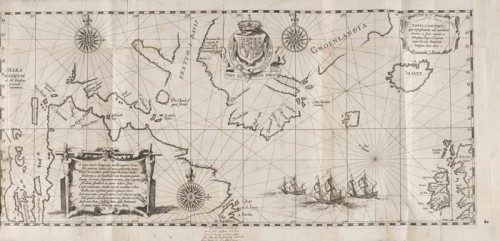
Tabula nautica, qua repraesentantur orae maritimae, meatus, ac freta, noviter a H. Hudsono Anglo ad Caurum supra Novam Franciam, 1612, part of: Descriptio ac delineatio geographica… of Hessel Guerritsz
The Dutch also formed a West India Company and began exploring and mapping the region. They established trading posts, rather than colonies, at Fort Orange (Albany) and elsewhere, at the confluence of the Hudson and Mohawk rivers, and devoted themselves to the fur trade, which would inevitably lead to conflict with the French. Other posts were set up at the mouth of the Hudson (Fort Amsterdam, on Manhattan Island), a strategic site, and further south, in the Delaware Valley, near present-day Philadelphia (Fort Nassau). The first immigrants sent to Manhattan were, for the most part, Protestant Walloon refugees. In 1626, the colony’s director general (governor), Pieter Minuit, concluded a famous deal, “purchasing” the island from the Lenapes for sixty florins. The soil was fertile, the climate healthy, and no Native attacks ravaged the settlement, which was named New Amsterdam and immediately became self-sufficient. Yet, there was little population growth. In 1630, the colony had only 300 inhabitants, like Plymouth. The Caribbean and East India were more attractive to those seeking to make a fortune. To attract colonists, a manor system (patroonship) was instituted around Fort Orange, but it failed to produce results; only Kiliaen van Rensselaer, one of the company’s wealthy shareholders, agreed to settle there.
The colony was divided into two economic zones; the north depended on the fur trade and the south on agriculture. Its immigrants were of very diverse origins; in addition to Calvinist Walloons and Huguenots, there were Lutherans from Westphalia, fleeing the ravages of the Thirty Years’ War, Puritans from New England (in Long Island in particular), and even a few Jews who sought refuge after the Portuguese captured New Holland, in Brazil (1654). The de facto tolerance, and not tolerance in principle, must not make us forget that deep religious prejudice existed, despite the mythical reinterpretations that have been published on the subject. New Amsterdam was not ahead of its time, and pragmatism accounted for a great deal where tolerance was concerned. Moreover, the Netherlands essentially imposed tolerance on the recalcitrant colonial authorities.
Relations with the Native Americans were also tense; two wars, in the 1640s and 1650s, resulted in massacres. Proximity to the New England colonies (Connecticut and New Haven) did not facilitate matters; there were conflicting territorial claims, and the first Anglo-Dutch War in Europe (1652–1654) complicated the situation in North America even more. A temporary arrangement had been reached with the Hartford Treaty (1650), and a border had been drawn, splitting Long Island into two parts, one English and the other Dutch.
Starting in 1647, the small colony was taken in hand by the energetic Petrus Stuyvesant, who did not know at the time that he would be its last director general. Indeed, because it was a Dutch enclave surrounded by English colonies, New Amsterdam was the collateral victim of Anglo-Dutch rivalry in the slave trade, particularly on the coast of West Africa. It was captured in 1664 without any real resistance, which would have been futile anyway, given the military superiority of the English expedition, reinforced by troops from New England. In the Treaty of Breda, which ended the second Anglo-Dutch War (1665–1667), the Netherlands opted to cede the small colony to England and keep the English possessions captured during the conflict, including Suriname, for its sugar resources, and the small island of Run, in the Moluccas (in present-day Indonesia), one of the world’s principal sources of nutmeg. What was still only a large village was renamed New York in honour of the Duke of York, the future James II. When placed within the context of the Netherlands’ seventeenth-century “empire”, New Amsterdam was not the “island at the centre of the world”, far from it.
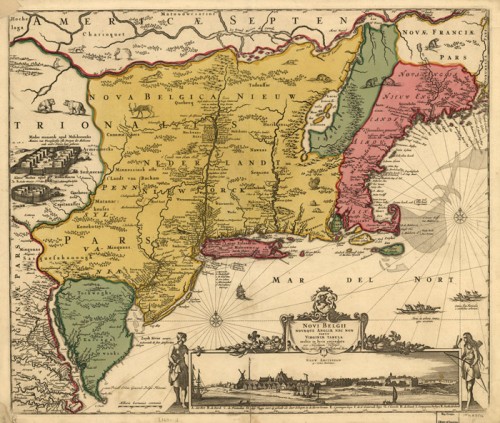
Novi Belgii Novaeque Angliae… (Map of the New Belgium or New Netherland), 1685, by Nicolaes Visscher
In 1660, the colony had 10,000 inhabitants, 1,300 of which lived in New Amsterdam. For a northern colony, it had a large number of slaves; about two out of five homes possessed them. It was essentially urban slavery, whereas in the South, slavery was exclusively agricultural. The population increased only after the English conquest; in 1685, 3,000 of the colony’s 15,000 inhabitants lived in New York City. The northern region, around Albany, remained very Dutch for a long time and was anglicized quite slowly, whereas Long Island had twelve English villages and five Dutch villages.
New Sweden
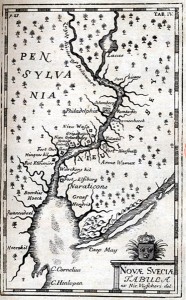
Novae Svecia scu Pensylvania in America, map from: Kort abeskrifning om beskrifning om provincien Nya Swerige uit America…(A short description of the province of New Sweden), 1702, by Thomas Campanius Holm
The Dutch also claimed the lands at the mouth of the Delaware River, further south, but given the lack of initiative on the part of the West India Company, a few Dutch merchants turned to the king of Sweden, who gave them his support. In 1638, Pieter Minuit, former director general of New Netherland, founded Fort Christina where Wilmington, Delaware, is now located. That marked the birth of Nya Sverige (New Sweden).
Commercially dependent on its Dutch neighbour, the small northern colony, whose inhabitants were of Swedish, Finnish, Dutch and German origin, had but a few villages. A group of Puritans from New Haven tried to settle there in 1642 but was quickly driven out. In 1655, Petrus Stuyvesant seized Fort Casimir, and New Sweden was absorbed by New Netherland.
Pennsylvania
New Netherland was not limited to the current state of New York; it also included Delaware and New Jersey, which the Duke of York divided in two (East and West Jersey) and granted to a number of proprietors, particularly Quakers. Puritans migrated to East Jersey in large numbers, and the two Jerseys were reunited in 1702.
King Charles II, brother of the Duke of York, paid a debt he owed to William Penn’s father in the form of a land grant, a vast concession in North America where Penn, who had converted to Quakerism, could set up his “holy experiment”. After preparing the migration in Europe, Penn arrived in North America in 1682 and founded Philadelphia, the City of Brotherly Love, at the confluence of the Delaware and Schuylkill rivers. Philadelphia was a genuine urban-planning project; rather than spreading out haphazardly, it was laid out as a grid, with wide rectilinear streets, in stark contrast to Boston, for example, with its narrow winding lanes directly inherited from medieval London. True, unlike Boston, Philadelphia was founded after the great fire that ravaged the English capital in 1666.
Immigration followed a pattern more along the lines of that in New England than in the southern colonies; Pennsylvania attracted relatively prosperous families, mostly from the middle class, with a clearly defined religious identity. The colony had exceptionally fertile soil, and prosperity came quickly, particularly because European (Swedish, Finnish, Dutch and English) settlers had been living in the region for decades. Pennsylvania welcomed Quakers by the thousands, mostly from England, but also from Wales and Germany, and they established homogenous communities such as Germantown. Tolerance, one of the colony’s founding principles, did not prevent the Quaker oligarchy in power from being looked upon unfavourably, or the English from showing prejudice against the Germans.
As a general rule, the population of the middle colonies was more heterogeneous that that of the Chesapeake region to the south and New England to the north. Furthermore, its growth was quite remarkable. The white population increased by a factor of eight in sixty years, from 63,000 people in 1710 to 520,000 in 1770. Due as much to natural growth as to immigration, the population explosion led to colonial expansion that was blocked only by the Native American allies of the French in the Great Lakes region, for example, or by the Appalachian Mountains, which formed a barrier. Demographic growth also spurred economic expansion; the soaring agricultural production made the region the granary of North America, supplying not only the domestic market, but also the Caribbean, Europe, and even Africa. The family farm remained the dominant model, as opposed to the South’s large plantations.
Also unlike the South, the middle colonies had few slaves; engagés (workers on contract) were hired instead. In Pennsylvania and Delaware, slaves never accounted for more than 5% of the population, and they were concentrated in cities such as Philadelphia. In this urban context, most slaves were craftsmen or worked in the service industries. On the other hand, in New York City, slaves accounted on average for 15% of the population, the numbers peaking at 30% in the mid-eighteenth century. In some counties of the colony of New York, over 20% of the population consisted of slaves. In this respect, the colony of New York differed from the others; although not strictly speaking a slave colony, it was without question a colony “with slaves”. In Pennsylvania, starting in the 1750s, the possession of slaves became increasingly common, despite opposition from the Quakers.
The middle colonies literally became central in the eighteenth century; Philadelphia and New York had 25,000 to 30,000 inhabitants, and their populations exceeded that of Boston before the middle of the century. The South never had a comparable urban centre, apart from Charleston, but to a lesser extent. Universities also developed in the region, often founded by Protestant churches, as well as a weekly press of growing importance in the creation of a public space, as in Boston.
The Southern Colonies
Jamestown and Virginia
When Jamestown was founded, the French were also trying to establish themselves in North America, under the direction of Samuel de Champlain in particular. Virginia was looked upon as a permanent settlement but remained a speculative enterprise; for a long time, its population consisted essentially of single young men, including numerous servants on contract, as opposed to that of New England and Pennsylvania, to which families immigrated.
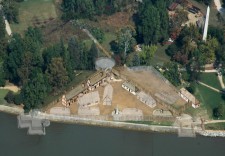 http://preservationvirginia.org, http://historicjamestowne.org” width=”225″ height=”156″ class=”size-medium wp-image-3095″ />
http://preservationvirginia.org, http://historicjamestowne.org” width=”225″ height=”156″ class=”size-medium wp-image-3095″ />Artist’s conception of James Fort
The first group of colonists settled on a strip of land that seemed naturally protected from attacks by Native peoples, and even the Spanish, but the real threat was the brackish water contaminated by dysentery, as well as mosquitoes that spread malaria. The combination of these two factors ravaged Jamestown’s population for several years. Moreover, the early immigrants were ill prepared to meet their needs, especially through fishing and agriculture. Like the English in Roanoke and the French in Florida, they relied on Native peoples for food. Since Jamestown was founded during the worst drought the region had known in several centuries, any surpluses the Native Americans might have been able to offer were considerably reduced. The Native peoples had barely enough to survive, so they could not meet the needs of the English parasites, who arrived at a really bad time.
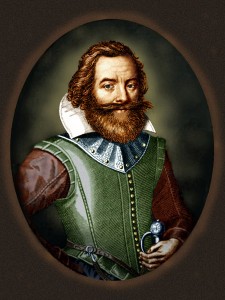 http://preservationvirginia.org, http://historicjamestowne.org” width=”225″ height=”300″ class=”size-medium wp-image-3104″ />
http://preservationvirginia.org, http://historicjamestowne.org” width=”225″ height=”300″ class=”size-medium wp-image-3104″ />Portrait of Captain John Smith
Further weakened by dissension, the colony was taken in hand by the energetic John Smith, but after the first winter, only 35 of the 100 or so settlers who arrived in April 1607 remained. At the same time, the colonists at Sagadahoc, although slightly less affected, abandoned their American experience. Once again, the very existence of an English North America seemed compromised, while French North America, which now extended as far as the St. Lawrence (Québec), was still at an embryonic stage.
In Jamestown, relations with the Native Americans were also deteriorating, and in the winter of 1609–1610 there was such a great famine that cases of cannibalism were reported, although their veracity is now questioned. In June 1610, unexpected reinforcements arrived, just as the survivors were preparing to return to England and put an end, once again, to the English presence in North America. Three successive governors, Lord De La Warr, Sir Thomas Dale and Sir Thomas Gates, managed to prolong the existence of a colony that remained fragile. After unsatisfactory results with the local variety of tobacco, which was too bitter, John Rolfe introduced a sweeter variety from Trinidad whose popularity spread like wildfire in England, despite King James’ aversion for tobacco. Virginia had finally found the export that would become emblematic of the colony and ensure its prosperity. Rolfe also made history by marrying Pocahontas, daughter of the chief of the powerful Powhatan Confederacy. Their marriage was a powerful symbol of hope, the marriage of the New and Old worlds, a marriage of cultures, but it remained an isolated case in the history of the English colonies; the French, and particularly the coureurs des bois, were much more open to interbreeding. However, the union sealed by the marriage helped preserve a fragile peace between the English and the Powhatans until 1622.

Portrait of Matoaka (Pocahontas), 1616, from The generall historie of Virginia, New England, and the Summer Isles, by John Smith
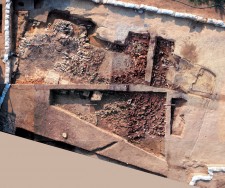 http://preservationvirginia.org, http://historicjamestowne.org” width=”225″ height=”188″ class=”size-medium wp-image-3091″ />
http://preservationvirginia.org, http://historicjamestowne.org” width=”225″ height=”188″ class=”size-medium wp-image-3091″ />View of the John White’s Site Ruin
Despite the terrible mortality — only a quarter of the four thousand colonists sent since 1618 remained! — the Native Americans found the English increasingly invasive, and feared the destruction of their environment and the loss of their way of life. The morning of March 22, 1622, they massacred 350 colonists, a quarter of the English population, reducing to naught the progress made over several years. The English quickly retaliated, but that did not prevent another massacre in 1644 (500 colonists), followed once again by fierce retaliation. One of the consequences of the 1622 “massacre” was the cancellation of the charter of 1606; Virginia became a royal colony in 1624. The fall of the Virginia Company was in fact orchestrated by some of its shareholders, who were annoyed because the venture had turned out to be a commercial failure.
 http://preservationvirginia.org, http://historicjamestowne.org” width=”150″ height=”96″ class=”size-thumbnail wp-image-3099″ />
http://preservationvirginia.org, http://historicjamestowne.org” width=”150″ height=”96″ class=”size-thumbnail wp-image-3099″ />Tobacco pipes and fragments of a clay sagger
 http://preservationvirginia.org, http://historicjamestowne.org” width=”126″ height=”200″ class=”size-thumbnail wp-image-3097″ />
http://preservationvirginia.org, http://historicjamestowne.org” width=”126″ height=”200″ class=”size-thumbnail wp-image-3097″ />Crucible
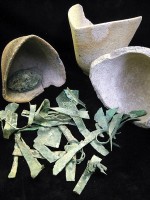 http://preservationvirginia.org, http://historicjamestowne.org” width=”150″ height=”200″ class=”size-thumbnail wp-image-3098″ />
http://preservationvirginia.org, http://historicjamestowne.org” width=”150″ height=”200″ class=”size-thumbnail wp-image-3098″ />Crucibles, copper pieces and smelted copper
During the civil war period in England, Virginia and its governor, Sir William Berkeley, distinguished themselves by taking an openly royalist stand. In 1652, three years after the execution of Charles I, Berkeley was deposed under (armed) pressure exerted by the Puritan Parliament. He was reinstated in 1660, when the monarchy was restored.
Like the other southern colonies, Virginia remained extremely rural; there were no cities, only plantations, along the many waterways that irrigated the immense Chesapeake Bay. Access to water was crucial for trade, and it was much easier to get around on water than on land. Given the absence of urban centres, religious structures were also poorly developed; after 1660, the Anglican Church once again became the official Church in Virginia and all the southern colonies, but there were very few churches and pastors, which explains why Quaker, and then Baptist, missionaries enjoyed so much success in the ever-expanding back country that was rather largely dechristianized.
The first slaves were sold by a Dutch ship in 1619, but slaves were not in the majority until the last quarter of the century. Before that, the workforce was composed of white engagés, who were let go after a certain number of years of service that paid for their crossing. The transition to a slave workforce occurred in the late seventeenth century and intensified in the eighteenth. Black people represented less than 10% of the population of the Chesapeake region in 1700, 25% in 1720 and 40% by 1760. Between 1700 and 1770, the white population grew from 90,000 to 400,000, and the black population, from 30,000 to 250,000. Despite the appearance of small villages and then towns, most of the Chesapeake region remained rural.
In the continent’s Thirteen Colonies, slavery was generally less harsh than in the Caribbean, not only because the climate was less hostile, but also because the masters prided themselves on their paternalistic image. Furthermore, as imports were reduced, slave families became relatively stable. The evangelical message was slow to be heard but essential in communities of African origin, despite difficult beginnings because masters feared that their slaves might interpret baptism as a form of emancipation. The pastors, Anglican for the most part, had to adapt their message to take the social stratification into account.
Maryland, a Catholic Enclave?
Slightly north of Virginia, there was a singular colony, founded by a Catholic, George Calvert, Lord Baltimore. Calvert had long been a shareholder in the Virginia Company, among others, and first launched a fishery venture in Newfoundland (in 1627), but he decided to settle further south because of the rigorous climate. He obtained a charter for the territories north of Virginia, which he named Maryland in honour of the queen, Henriette-Marie, Louis XIII’s sister, but also as an indication of his Catholicism.
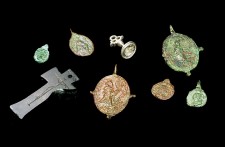 http://preservationvirginia.org, http://historicjamestowne.org” width=”225″ height=”147″ class=”size-medium wp-image-3082″ />
http://preservationvirginia.org, http://historicjamestowne.org” width=”225″ height=”147″ class=”size-medium wp-image-3082″ />Religious artefacts
Led by Calvert’s son and heir, and accompanied by Jesuits, the colonists arrived in the spring of 1634. They suffered less than the Jamestown pioneers because they could count on neighbouring Virginia for supplies. Furthermore, the Piscataways (or Conoys) viewed them as useful allies against their enemies, the Susquehannocks. The geopolitical scenario was more akin to that of Plymouth than of Jamestown.
As in Virginia, the principal crop was tobacco, which implied a similar workforce and a settlement pattern that was just as dispersed — so, no cities. Maryland experienced troubled times during the civil wars; a flood of Puritans from Virginia, driven out by Governor Berkeley in 1643, was joined by another group in 1648. Paradoxically, the Catholics were now a minority in their own colony. That is one of the reasons a tolerance law was proclaimed in 1649. However, this must not be misconstrued as the early advent of the principle of tolerance; the objective was to punish intolerance in order to guarantee a certain cohesion in a multidenominational colony. In the 1650s, the Puritans seized power by force, but they ended up ceding it to Lord Baltimore at the end of Cromwell’s reign in exchange for amnesty.
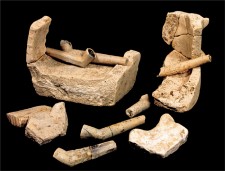 http://preservationvirginia.org, http://historicjamestowne.org” width=”225″ height=”171″ class=”size-medium wp-image-3088″ />
http://preservationvirginia.org, http://historicjamestowne.org” width=”225″ height=”171″ class=”size-medium wp-image-3088″ />Tobacco pipes and fragments of a clay sagger
Socially, the male–female imbalance was progressively attenuated. Initially often widows, women saw their power increase before the patriarchy typical of the South got the upper hand. The Southern woman then found herself confined to domestic circles. In addition, people began marrying at an earlier age. The mortality rate remained high, but life expectancy increased to the fifties, and more and more children reached adulthood. New figures also appeared in the Southern family — grandparents — who had been present in New England from the outset.
As in the other regions, natural population growth was supplemented by immigration; 42 new counties were created between 1721 and 1776 in Maryland and Virginia alone. The push west was inexorable as the population density progressively increased. This densification was accompanied by the creation of family networks and the emergence of a social and political elite, essentially through intermarriage. In the eighteenth century, a veritable “anglicization” of tastes and aspirations occurred in the colonies, particularly in the South. People tried their best to imitate the gentry of their homeland by building brick manors in a classical style, taking up reading, and keeping up to date on the authors and works that were popular in the Old World. Luxury items acquired an importance that was unheard of until then in colonial societies; rugs, silverware, vases, as well as musical instruments, made their way across the Atlantic. The ads published in newspapers announcing newly arrived shipments reveal that tastes and aspirations became more refined and more complex; merchandise descriptions became increasingly precise, detailed and differentiated, and focused as much on the quality of the items as on their origin. Some ads, mainly for books, even specify what one had to read to appear in the know.
In the South, this trend was accompanied by the development of a new sociability that would later become emblematic; Southerners, especially the most affluent, acquired a passion for gambling, balls and horse racing. Broadly speaking, ostentation, hedonism and a taste for luxury suddenly emerged, and then reigned, leading to a worrisome debt burden. The pastors, essentially Anglican outside the back country, cautioned against these developments and the accompanying permissive morality, in contrast with the more unyielding evangelism of the back country, which, by definition, was still underpopulated.
From Carolina to the Carolinas
The lands located between Virginia and Florida had been granted to Sir Robert Heath as early as 1629 under the name Carolana. They were supposed to be a refuge for the Huguenots who had survived the siege of La Rochelle and flocked to England, but the enterprise never got off the ground.
Shortly after the restoration of the monarchy (1660), a group of influential aristocrats obtained a charter for the lands in question. Anthony Ashley Cooper, the future Lord Shaftesbury; Edward Hyde, Count of Clarendon and principal minister of Charles II; and George Monck, Duke of Albemarle, a general in Cromwell’s army who had facilitated the return of the Stuarts, were among the eight proprietors. In return for a declaration of allegiance to the Crown, the colonists could benefit from freedom of conscience — as long as it was limited to Protestantism.
Carolina was a “colony’s colony”, as colonization was largely from within the Americas; it absorbed a population that did not find land in the Barbados, where the cultivation of sugar had been accompanied by high land concentration. One advantage was that the colonists were already acclimatized, greatly increasing their chances of survival. The first contingent of about 800 Barbadians was joined by a group from New England, but both were disappointed with the lands around Cape Fear, considered poor, and the settlement was abandoned.
Peace with Spain (1667) eliminated the threats from the south and made colonization less risky. Shaftesbury and his famous secretary, John Locke, drafted the Fundamental Constitutions, which guaranteed religious tolerance — still restricted to the different variants of Protestantism — while proclaiming that Anglicanism was the official religion. A new settlement founded at the mouth of the Ashley River in 1670 and called Charles Towne was later moved to the confluence of the Ashley and Cooper rivers and renamed Charleston. Two years later, 271 men and 69 women were living there. When the Edict of Nantes was revoked (1685), Huguenots flooded into South Carolina. Carolina was supposed to have an extremely hierarchical aristocratic social organization, but that remained largely theoretical for the most part. Originally conceived as a single colony, it was divided into two provinces, Albemarle to the north and Clarendon to the south, the ancestors of the current states of North and South Carolina.
The initial plans to produce silk, plant vineyards, and cultivate ginger and olives quickly evaporated because the land was unsuitable. Yet, the colony soon became self-sufficient in food supplies and had a special trade relationship with the Caribbean. A profusion of game, particularly deer, made the export of furs possible, especially since the Native Americans were generally willing to trade with the colonists. In the early eighteenth century, the cultivation of rice, most certainly imported from West Africa, developed rapidly, giving the colony very profitable exports.
South Carolina was different from the other colonies because it had a very high concentration of African slaves, who soon outnumbered the white population. That provoked a certain amount of anxiety; the colonists lived in constant fear of slave rebellions. Those fears were confirmed when the Stono Rebellion broke out in 1739. As for the province of Albemarle, which would become North Carolina, it did not really develop; given the absence of cities, its population remained quite scattered, and its economy boiled down to subsistence agriculture and a little tobacco growing. For a long time, it remained the least developed English colony in North America.
Georgia: The Glacis as a Form of Philanthropy
The founding of Georgia, the last British colony founded before the American Revolution, was motivated by both geostrategic and philanthropic considerations. In 1732, George II granted James Oglethorpe and his associates the lands located between the Savannah and Altamaha rivers. The initial idea was to give a second chance to unfortunate people whose debts had landed them in prison, as well as to religious refugees, such as the Moravians, the Lutherans recently expelled from Salzburg, or forty or so Portuguese Sephardic Jews. Slavery, as well as the production, importation and consumption of rum and other spirits, were prohibited. In time, however, pressure exerted by Anglican evangelist George Whitefield contributed to the establishment of slavery. Prohibition rendered Georgia much less attractive than its northern neighbour, South Carolina, where one could consume and sell alcohol (particularly to the Caribbean colonies) while growing rich from the labour of large numbers of slaves. More prosaically, in an increasingly tense diplomatic context between Great Britain and Spain, it became crucial to populate that buffer zone between South Carolina and Florida. In other words, to turn it into a glacis.
Conclusion (show)
In the mid-eighteenth century, Spain’s hegemony was but a distant memory, and the golden century seemed quite tarnished. The Dutch had been without possessions in North America for almost a hundred years, and Great Britain and France were the ones vying for an increasingly global imperial supremacy. Great Britain had considerably consolidated its empire on the North American coast, with the exception of Florida, which remained in Spain’s fold. While much less populated than the British colonies, New France now covered immense territories — from Louisiana to the St. Lawrence, and the Illinois Country to Acadia — that seemed to enclose Britain’s possessions. However, the British would emerge victorious in the first act of the “second Hundred Years’ War” and seize the “few acres of snow” neglected by France, before a colonial revolution brought an end to their American empire.
Suggested Reading (show)
Andrews, Kenneth R. 1984. Trade, plunder and settlement: Maritime enterprise and the genesis of the British Empire, 1480–1630. Cambridge: Cambridge University Press.
Bradford, William. 2004. Histoire de la colonie de Plymouth : chroniques du Nouveau monde (1620-1647). Edited by Lauric Henneton. Geneva: Labor et Fides.
Bremer, Francis J. 2003. John Winthrop: America’s forgotten founding father. New York: Oxford University Press.
Bremer, Francis J. 1995. The Puritan experiment: New England society from Bradford to Edwards. Revised edition. Hanover, New Hampshire: University Press of New England.
Cottret, Bernard, Jacques Pothier, Lauric Henneton and Bertrand Van Ruymbeke. 2008. Naissance de l’Amérique du Nord : les actes fondateurs, 1607-1776. Paris: Les Indes savantes.
Hatfield, April Lee. 2004. Atlantic Virginia: Intercolonial relations in the seventeenth century. Philadelphia: University of Pennsylvania Press.
Horn, James P. P. 2005. A land as God made it: Jamestown and the birth of America. New York: Basic Books.
Jacobs, Jaap. 2009. The colony of New Netherland, a Dutch settlement in seventeenth-century America. Ithaca: Cornell University Press.
Kupperman, Karen Ordahl. 2008. The Jamestown project. Cambridge, Massachusetts: The Belknap Press.
———. 2007. Roanoke: The abandoned colony. 2nd ed. Lanham, Maryland: Rowman & Littlefield.
Landsman, Ned C. 2010. Crossroads of empire: The middle colonies in British North America. Baltimore: Johns Hopkins University Press.
Mancall, Peter C. 2007. The Atlantic world and Virginia, 1550–1624. Chapel Hill: University of North Carolina Press, for the Omohundro Institute of Early American History and Culture.
Meinig, D. W. 1988. The shaping of America: A geographical perspective on 500 years of history. New Haven: Yale University Press.
Middleton, Richard. 2002. Colonial America: A history, 1565–1776. 3rd ed. Oxford: Blackwell Publishers.
Rink, Oliver A. 1989. Holland on the Hudson: An economic and social history of Dutch New York. Ithaca: Cornell University Press.
Roper, L. H. 2009. The English Empire in America, 1602–1658, beyond Jamestown. London: Pickering & Chatto.
Roper, L. H., and B. Van Ruymbeke. 2004. Conceiving Carolina: Proprietors, planters, and plots, 1662–1729. New York: Palgrave Macmillan.
Rutman, Darrett Bruce. 1972. Winthrop’s Boston: Portrait of a Puritan town, 1630–1649. New York: Norton.
Shorto, Russell. 2004. The island at the center of the world: The epic story of Dutch Manhattan and the forgotten colony that shaped America. New York: Doubleday.
Van Ruymbeke, Bertrand, and Randy J Sparks, eds. 2003. Memory and identity: The Huguenots in France and the Atlantic diaspora. Columbia: University of South Carolina Press.
Wood, Peter H. 1974. Black majority: Negroes in colonial South Carolina from 1670 through the Stono Rebellion. 1st ed. New York: Knopf.




